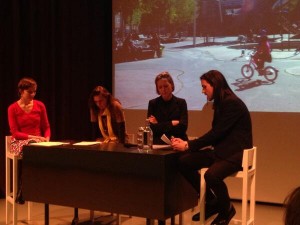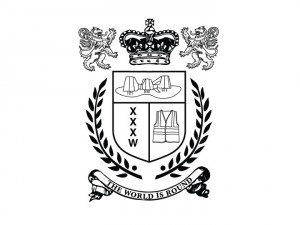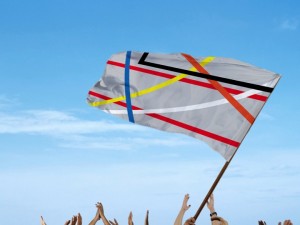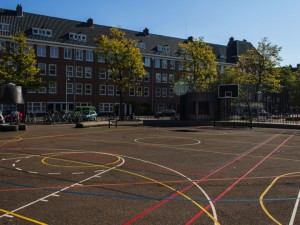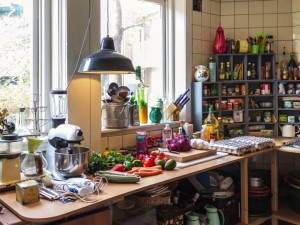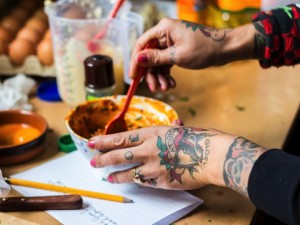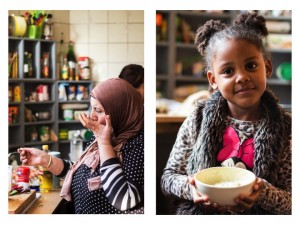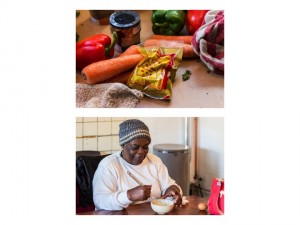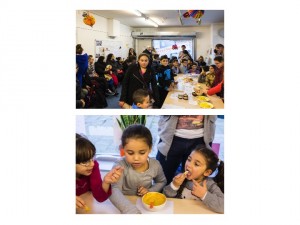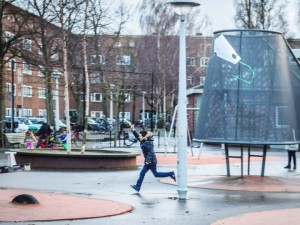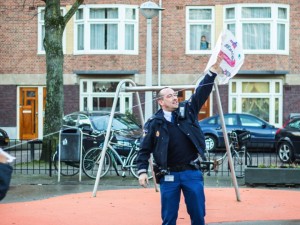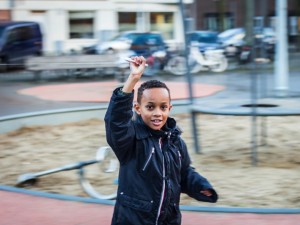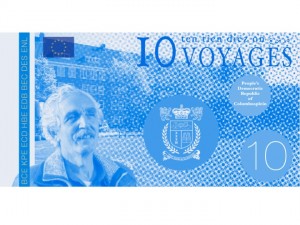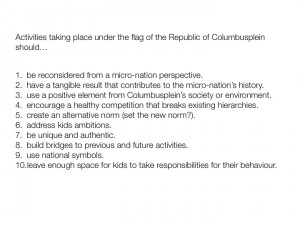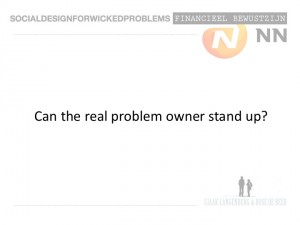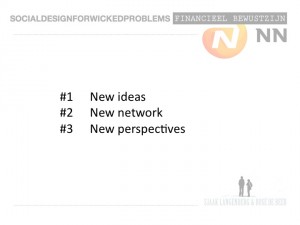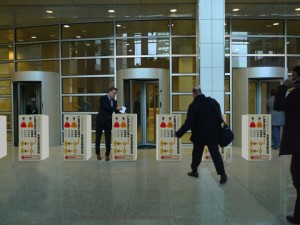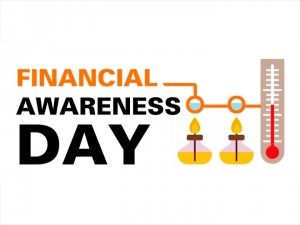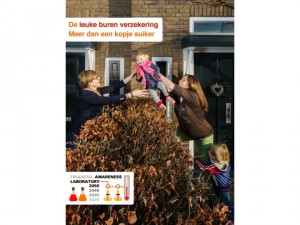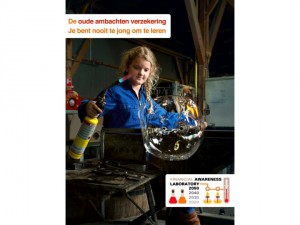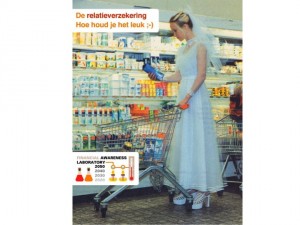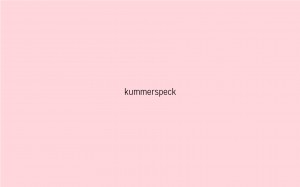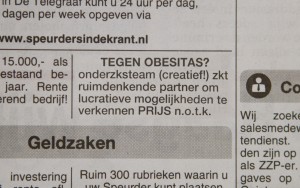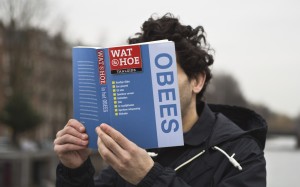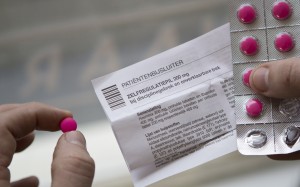Verslag publieke bijeenkomst #4
Opdrachtgevers aan het woord
15/01/14 – auditorium Het Nieuwe Instituut, Rotterdam
Welkom: SDFWP is een publiek onderzoek naar de inzet van social design methodes bij taaie vraagstukken. Gestart vanuit de overtuiging dat kunstenaars en ontwerpers een waardevolle bijdrage kunnen leveren aan
complexe problemen. We houden twee besloten en vier publieke sessies, dit is publieke bijeenkomst nummer vier. Op 17 februari is ook de laatste besloten bijeenkomst. Die bestaat uit het voorleggen van conclusies uit het onderzoek aan een groep van experts. Medio maart zal de publicatie over het onderzoek af zijn.
Amsterdam West Columbusplein
Het ontwerpteam doet een re-enactment van hun ontwerpproces op het podium van het auditorium van Het Nieuwe Instituut:
THE AMAZING STORY OF THE REPUBLIC OF COLUMBUSPLEIN
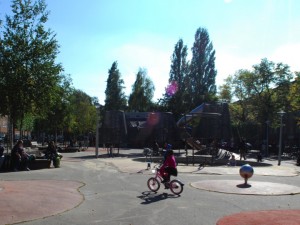
Let us start from the beginning. Not long time ago there was this big square in Amsterdam West. In such a crowded city as Amsterdam, having such a big square is a privilege, but somehow there was something lacking in the neighbourhood. Kids were mean to each other, and neighbours from a multi cultural background had trouble to become a real community. There were lots of social organisations working in the area, but they were looking for a different approach to make things work.
Then somebody came up with this crazy idea of creating a new micro-nation. But unlike any other nation, here the neighbours could fully participate in its creation. They called it the Republic of Columbusplein.
Social Worker: Were the social organisations involved in this micro-nation?
Artist: In the beginning only a few, as the micro-nation idea showed lots of potential.
Amsterdam West: And what was their reaction? Sounds like a lot of work.
Designer: Actually that was their first reaction, but it could also give the social workers a new point of view in the future. The micro-nation idea generated a new kind of energy around social workers.
Social worker: vertelt over sport/luchtkussen, individueel werken van organisaties.
Amsterdam West: okay all this sounds very nice, but where do you start to build your own nation? Sounds like a lot of fantasy to me.
Artist: Well, they needed a way to introduce themselves to the rest of the world. They needed a flag. A flag that would represent the diversity of the community and all the different backgrounds and cultures that live in it.
Social Worker: I like it, but who made it?
Designer: it looks like the sports field right? Nice…
Social worker: Yeah but then, it was made up by a designer right? Were the neighbours actually creating something by themselves?
Amsterdam West: It sounds like a cheap fix, as if the designers already worked it out completely. And it looks very institutionalised.
Is the nation already there or are they still creating it???
Artist: Well, I guess someone thought it was a good idea to give the micro-nation a first push, to encourage the neighbours and organisations to get out of the same loop. But from then on, the citizens would be the real protagonists of the story.
On a sunny day on the square of Columbusplein, the kids were talking about how much they loved food. Everybody shared a passion for their local cuisines: different ingredients and flavours coming from all over the world. That’s when a national cooking contest was arranged. The challenge would be creating a new sauce for fries, the beloved national snack.
Designer: That’s actually a nice idea because everybody can relate to something as simple as a sauce for fries. And it also shows that a micro-nation can grow out of other things than rules and structures. It could help social organisations realise that is promising to adapt their activities to the micro-nation concept, to be part of something bigger.
Social Worker: But you also need to understand that some social organisations have been active for the past 15 years and that is hard to change their mindset.
Amsterdam West: Okay, but how does this relate to our central question? Call me whatever, but I can’t see how a fries sauce is going to make a difference within the community.
Artist: Well for starters, everybody shared the same kitchen, they used their favourite ingredients and tricks, and together they created more than 18 sauces. There were adults and kids, people coming from Morocco, Turkey, Surinam… together for the first time.
Designer: It’s nice to see them together having a good time, all making an effort to contribute to the national sause.
Amsterdam West: yeah but we have organised community lunches before, what’s the difference here?
Designer: Well, I guess it was the first time that the nation was creating its own history, so it’s not only about what happened that day but how the cooking contest will affect the nation in the future. This gave the neighbourhood the chance to start a positive story together.
Artist: And, since Columbusplein is a democracy, all the neighbours were invited to come over, try the sauces and give their vote.
Amsterdam West: Didn’t that become a total mess?
Social Worker: I remember this event! I was asked by a colleague of mine to help at the very last moment because things were getting out of control. But later on, when we reflected together upon it, the fact that the event wasn’t structured allowed us to observe the natural interaction between the kids.
Artist: Exactly. The story says that one of the kids forced en put pressure on all his friends to vote for him, so he could win. He only joined the workshop to make fun of it. So he was disqualified from the competition, giving the chance to win to people who worked hard on their sauce.
Designer: This is important, cause it was probably the first time during an activity that the hierarchy was broken and that the toughest kid did not win. So coking back to the initial questions, bullying was indeed addressed here, but in an indirect way.
Amsterdam West: This is interesting cause here the problem solving dynamic is replaced by a more positive approach.
Social worker: And this is something completely new. Usually when we organise football games for example, we always know who’s going to win. But here the kids don’t know what to expect, everything changes… Also interesting is that when you don’t completely structure the activity, you can see better how group dynamics between the youngsters normally would work and do something with it. The sauce broke the hierarchy in a way. A new norm is established.
Amsterdam West: What I understand until now is that the micronation concept is an tool to create and unleash energy and that the energy of people involved could create a common focus. This is different form how we would normally do it.
We would normally first analyse the problems and then try to establish a common focus of professional and citizens to address the problems. But we would have to put a lot of energy in getting people to act.
But who won?
Artist: Actually, a 9 year old girl, who worked very hard on her sauce, Sophie, was the winner. She used more than 15 ingredients. Here you can see the district major handing her the winner’s cheque. Now the sauce is going to be used in local restaurants, produced by the neighbours and might be even sold in local markets.
Designer: It’s nice to see how much can come out of an activity that’s so simple, and showing kids that effort pays off and that everybody can be part of the micro-nation. The value of this activity goes beyond the activity itself.
Social worker: What triggers me is that they put little Sophie’s portrait is featured on the nation’s first stamp, building the micro-nation’s history. To create something beyond the activity itself.
Is this all they did for the micro-nation?
Artist: Well, by that time the Republic of Columbusplein started to feel like real, so they thought that if they wanted to become a really strong nation they should have their own Space Program. They even organised a trip to the European Space Agency to get inspired! And after that they created their first mission, where kids were invited to create their own kites and fly them at the Columbusplein Square.
Social Worker: a Space Program? Isn’t that a bit too much for a micro-nation?
Designer: That’s the point. It addresses the ambitions of the kids, something very important as well. They can dream about becoming something else than football players or rappers for example.
Amsterdam West: So it’s again about this intangible energy that makes everyone excited about the micro-nation idea. We are continuously talking on activity level, I still feel the need to conceptualize this: how this refers to our main questions …
Artist: a few interesting things happened during the kite workshop. All the kids were very happy and proud of making their own kites, but when they went outside to fly them, some other kids who where in the neighbourhood started to make fun of Loay, one of the participants.
Designer: probably they mock him because he was playing with kites, while they are supposed to project an image of tough kids when they are in the square…
Social Worker: yeah, but the interesting thing is that I heard that Loay decided to continue, started to run around flying his kite, and a few minutes later the other kids had to sit down and watch the rest having fun, wondering why they didn’t join the workshop.
Amsterdam West: was the police also involved?
Artist: Not really, it was kind of spontaneous, the same way some social workers joined the Space Program and created an amazing Space Shuttle with a bike pump that could launch a plastic bottle up in the sky… the kids loved it!
Designer: seems like it was the first time that social workers created something of their own within the idea of the micro-nation.
Social Worker: Well I think the rocket engineer is here in the audience. Could you please stand up and tell us why did you leave your desk that afternoon and decided to build a rocket for the Space Program?
Maaike: The first reason was because I wanted to participate actively in an activity with the kids cause I can learn a lot from this experience and plus it looked like so much fun. But also it was important that my boss believes in the micro-nation project and gave me the freedom to build this rocket. Also the activity was open and inviting to contribute to it, while organising a football game for example leaves no room for creativity. It felt really good, I didn’t feel like working at all that day, even if I worked really hard.
Social Worker: To me the value is that social workers and kids would get more involved because they are part of something big, something completely different, and they can actually make a difference in the community, go beyond their job duties.
Amsterdam West: yes but that means a bigger commitment, a bigger effort… do you think every social organisation would fit under this program?
I mean, the micronation is still a construct and you are still the main drive behind it, organizing the activities.
This does not fit the world of organizations.
Social Worker: probably not. We would need people that want to make an extra effort and who are excited about having a positive impact in the community. So we would still need to have people, time and energy to keep the micronation going…And professionals need to have the opportunity to act outside of their opdracht.
And how much activities do we need to organize for something substantial to be out there?
Artist: that is very true. The micro-nation works like an open source, where everybody has access to it as is welcomed to participate and modify it, but you need to be committed to the idea, feel excited about being part of something as big as creating your own nation.
Amsterdam West: Maybe Martien could ask some of your workers how would they contribute to the micro-nation…
Social Worker: We’ve just hired Frank to teach Jiu-Jitsu to the local kids, and I think he’s in the audience as well. Frank, how would you contribute to the micro-nation approach?
Frank werkt op columbusplein. De filosofie van Jiu Jitsu is om met een kleine inspanning om te gaan met aanwezige energie. De micronatie biedt heel veel mogelijkheden: vanuit lokaal concept
vechtkunst als verlengde van Columbusplein. Op de Albert Cuyp betrekken ze de boksschool ook bij de veiligheid op de markt.
Designer: Thanks Frank. That’s a very good example of how social workers could take over the ownership of the micro-nation.
Amsterdam West: Did they come up with more ideas to establish the micro-nation of Columbusplein?
Artist: Actually they did. For example do you remember Sophie, the winner of the Colombussaus contest? Her prize was a 1000 Voyages cheque. Voyage is the name of Columbusplein’s alternative currency that could help local businesses to be more involved in the nation’s existence.
Designer: Plus is a way to recognise the people who actually make a difference in the neighbourhood, cause I know the guy whose face is in the banknote. His name is Seyit and he’s a very well known social worker in that neighbourhood.
Amsterdam West: guys, I truly like this idea, to get it any further I’d like to present it to my organization and the directors of the organizations involved, but we must translate this concept into a their language, so they can understand the potential of it. There are also some problems to address still. I also feel it is still too soon. We need to experiment more in real time to understand how and if it would work.
Social worker : what would help us for a first step is if we can summarise these experiences into “standards”. This can be turned into a scoresheet that social organisations can use to evaluate and transform their activities.
Designer: This is what the artists came up with.These are tools that could help social organisations to involve the neighbours of Columbusplein into creating their own nation.
Artist: Now we want to welcome you to reflect on the amazing story of the Republic of Columbusplein and the standards that rule this country.
THE END
ING // Nationale Nederlanden
Transitiefase bank en verzekeraar, wie is de probleem eigenaar?
Actief in 18 landen, 12000 werknemers.
NN is de nieuwe naam. We hebben een Kunstcollectie, we willen niet alleen verzamelen, maar ook sociaal bijdragen.
Samengewerkt met Sjaak & Rosé. Wat hebben we geleerd, en wat gaan we doen? Wat is de meerwaarde van kunstenaars in het bedrijfsleven? Waarom was dit een succes?
Ons vraagstuk: hoe gaan we financieel bewustzijn vergroten
Juist ook intern, binnen de organisatie.
Wat heeft het opgeleverd
#1 Nieuwe ideeën
#2 Nieuw netwerk > netwerkdenken, lukt vaak nog niet
#3 Nieuwe perspectieven
Taaie vraagstukken zitten genetwerkt in elkaar, je pakt ze niet alleen aan.
Doelen gebruiken die voor kunstenaars gewoon zijn, maar bij ons niet
Heel glad ijs, ‘How to look at the world like an artist.’
“It’s not where you take things from, it’s where you take them” (Godard)
Press play, don’t pause. Kunstenaars beginnen echt. Gaan direct doen.
Op zoek naar houvast, hoe spreek je ook de taal van de organisatie.
Altijd vertrouwen op intuitie, dat doen we niet, durven we niet.
Gezamenlijk oplossen van het probleem is best lastig
Als ik naar de directie ga?
Wat veroorzaakt het wanneer ik zeg: : “We moeten een datingsite starten.”
Tussentaal wordt extreem belangrijk.
Is dit een vrijdagmiddag-borrel- grap?
Sjaak en Rosé hebben de taal leren spreken, hadden ook bedrijfsgevoel en wisten dit uit te dragen.
Hoe kom je tot ideeën? Dat is als zangers vragen hoe ze zingen.
Ter opfrissing: wat hebben Sjaak en Rosé precies gedaan.
Van praktische tot futuristische en absurde ideeën.
Spagaat, interessante discussie.
Misschien moet je een keuze maken.
Naar directie met één idee, zoals de datingsite.
Kern van verzekeren gaat ook over solidariteit.
Wat kunnen we leren van goede doelen.
Slagen er goed in om gevoel te genereren van ‘samen schouders eronder’
Waarom laat je callcenters niet gewoon zien (zoals bij TV geld ophaal acties).
Of:Hoe futuristisch zijn jullie als bedrijf?
Oude computers bij NN.
ZZP loterij. Eén van de problemen bij zzp’ers is dat ze vaak niet zijn verzekerd.
Arbeidsongeschiktheidverzekering is duur.
Hoe maak je de drempel lager.
Bijvoorbeeld je lot is een minipremie.
We hebben lekker geen keuze gemaakt:
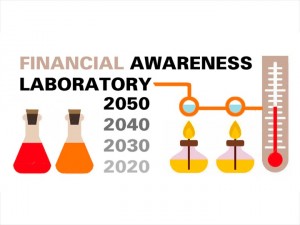
Financial Awareness Laboratory.
Ruimte voor experiment in organisatie
Onze eerste stap was een enquete:
– wie of wat zou je willen verzekeren wat je nu niet kan verzekeren
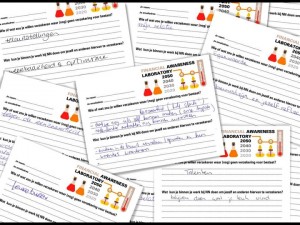
Wat willen mensen nu precies verzekeren?
Financieel bewustzijn is geen doel op zich.
Niet digitaal maar enquetes bij beveiligingspoortjes, Waardoor men anders door die poortjes gaat.
Interessante concepten achterhalen, wat zou een nieuw soort dienstverlening zijn?
Ook: gelijkgestemden vinden
Financial Awareness Day, 10 ideeën uitgebreid doorlichten.
Alle partners en geinteresseerden ook hiervoor uitnodigen.
De leuke buren verzekering. Meer dan een kopje suiker.
De relatieverzekering, hoe houd je het leuk.
Meer beweging organiseren, en kanaliseren van energie.
Hoe vertalen we deze woorden naar de directietafel.
We hebben één kans, we willen het groots aanpakken.
De reis heeft tussenstations, geen eindstation.
Sjaak reageert: mooi, nu zien we hoe het is overgenomen
Financieel bewustzijn kunnen we niet opleggen
Iedere keer hadden we een afspraak, maar steeds zat er een nieuw iemand bij.
Soms had iemand heel specifieke kennis op elk van de onderdelen.
De olievlek werd groter.
Binnen dit ontwerptraject was veel aandacht voor de strategie binnen de organisatie.
Lino Hellings / Waarmakers / Obesitas
We hadden geen stakeholder aan de start van ons onderzoek
We zijn op zoek gegaan naar een mogelijke opdrachtgever. We hebbn gesproken met veel wetenschappers, ervaringsdeskundigen en een pinterest bijgehouden met verslagen van gesprekjes, video’s, eetexperimenten.
We hebben de volgende personen en organisaties gesproken:
• Mary-Ann Schreurs, wethouder innovatie en design van de gemeente Eindhoven
• Jeanne Kneuzen, van het Technasium uit Tilburg
• Een pharmaceutisch bedrijf, er was geen draagvlak binnen het bedrijf
• Een zorgverzekeraar, hiermee zijn we nog in gesprek
Voor ons inhoudelijk onderzoek hebben we vocabulair aangelegd. Een herdefiniëring gemaakt voor het taaie probleem: oorzaak is een slecht functionerend intern navigatiesysteem, gebrekkige disciplinespier.
We gaan het onderzoek voort zetten bij gemeente Eindhoven.
Welke partners interessant om daar mee samen te werken: Eindhoven, Philips Lab, Design Academie etc.
Uiteindelijke doel is ontwerpen van product, dat het innerlijk navigatiesysteem gaat ondersteunen.
1. Gidsje: Hoe & Wat in het Obees
Op basis van een gesprek met een vriend met obesitas: Ik wil het verschil tussen wij & zij opheffen. Obesitas met humor bespreekbaar maken. In coproductie met obesitaskliniek in Eindhoven. Wandelingen door de stad
2. Placebo’s met bijsluiters.
Voor mensen met overgewicht, maar ook voor het algemene publiek
Zoals: zelfregulatiepil, werking en bijwerkingen worden beschreven.
Bijvoorbeeld: met studenten Design Academie of de TU/e.
tentoonstelling met kleurrijke pillen, verpakkingen en bijsluiter.
3. Obecity, internationaal onderzoek
Participating Artists Press Agency (Papa), veldwerk methode: internationale correspondenten met een vraag op pad gaan.
Steden waar we een netwerk hebben met co-auteurs en fotografen een tentoonstelling of krant maken: obesitas wereldwijd.
Mary-Ann Schreurs wethouder van innovatie, cultuur en openbare ruimte in Eindhoven reageert:
wetenschappers en kunstenaars zijn zo belangrijk, want ze houden zich niet aan de regels. Bij dit soort problemen moet je juist niet aan de regels houden.
Woorden die we gebruiken hebben een oordeel in zich het is een wij/zij discussie, met een zondebok.
We zij nu nog erg zoekend, we weten nog niet wat eruit komt. Dat is redelijk normaal, het goede van deze tijd is dat het een transformatietijd is; Het concept van blauwdruk laten we achter ons.
Je moet een idee hebben van waar je naartoe wil bewegen. Je probeert stappen te zetten in de juiste richting.
In innovatieprogramma in Eindhoven geldt: het is een iving lab, je mag het hier uitproberen, mits je het doet met degene voor wie het bedoeld is.
André: Hoe creëer je zo’n sfeer binnen de organisatie?
Wethouder: Het is makkelijker om je aan regels houden, afrekencultuur, wat het overstijgt: dat je met elkaar het juiste wil doen. Met kleine stapjes doen.
Het designprogramma is bedoelt om echt te experimenteren, te testen of het zou kunnen lukken,. Innovatie gaat om het uitrollen in samenleving, schaalgrootte.
André: Hoe bed je dit in in een organisatie, als je als social designer impact wil hebben, werken met productbudgetten ipv. cultuurbudgetten.
Wethouder: nu in designbudget, inbedding in organisatie gaat dan later.
Degene die de beslissingen neemt moet meedoen, het zit in het doen.
Omdat ze het dan de moeite waard vinden.
Wat draait een organisatie? Dat heeft niets met geld te maken. We gaan van een geldgedreven maatschappij naar waardegedreven maatschappij. Soms is het handig om bovenaan in de organisatie te beginnen.
André: Nu hebben we 3 organisaties die doorgaan na het traject, dat hadden we vooraf niet durven te bedenken.
De sleutel zit dus in het doen. Geldgedreven maatschappij / ecologie.
Dit loopt parallel aan de strategische beslissing: financial awareness. Er is een enorm verschil tussen publieke en private organisatie, maar hierin zit toch een parallel.
May-Britt Jansen: Het was cruciaal dat we Martien Kuitenbrouwer – de stadsdeelvoorzitter van Amsterdam West hadden betrokken. Je moet het op een goed niveau beleggen.
Martien K: soms helpt het om aan de top beginnen, soms aan de top en bodem beginnen. Het woord pilot en experiment heb ik afgeschaft, namelijk: Je moet het gewoon gaan doen, pilot heeft ook een valse veiligheid. Ga het maar echt ondervinden.
Wethouder Eindhoven: pilot is wél definitief, gaat om uitvinden, maar het beklijft wel.
A’dam west: Hoe vertaal je het naar de organisatie. Soms gaat het om de ervaring, en beschrijving van het project. Doe geen standaard evaluatie, maar loop een dag mee en dan ervaar je hoe het is
niet meteen een blauwdruk maken, zoals vaak een vraag is vanuit de politiek. Vertellen en meemaken, dat doet veel meer dan die blauwdruk. Het doen is het werk, uitproberen en uitrollen is ander proces.
Je moet ook als team connecties maken. De tussenlaag in een organisatie is ingewikkeld, want die vertaalt! In het middenmanagement mis je vaak die interactie, het vertalen van wat er buiten gebeurt, naar rationele type beslissingen, top is juist ook emotioneel, ook gevoed door sentiment van buiten. De middenlaag is continue bezig te vertalen, maar haalt de creativiteit eruit, die vertaalmanier moet zo dat het waarde doet aan het proces. Het gaat immers om creëren van waarde.
Marlieke Kieboom van Kennisland: het moet wel leuk blijven, wat doe je als het niet meer leuk is, hoe helpt social design om verder te komen.
Lino: Het was best lastig, de samenwerking tussen mij als kunstenaar en de ontwerpers. Het duurde even voordat we elkaars taal spraken. Doorzetten heeft ons gered en lief zijn…
Eerst zeiden we: we’re working apart together, eerst aparte presentatie. Bij de 3e presentatie hebben we doorgenokt en het samen gedaan. Wel erg leerzaam.
Wethouder: altijd moeilijk in begin, je werkt altijd vanuit het eigen systeem.
Organisaties hebben allemaal eeen eigen manier van acteren, je bent niet bezig met het probleem, maar met je eigen stukje.
Designers kunnen ervoor zorgen dat niet je eiegen belang op tafel ligt, maar iedereen gaat weer zien waar het om gaat en wat de eigen bijdrage kan zijn. We willen dat dingen functioneren voor mensen.
Klaas: De vraag uit het publiek was: zijn er momenten dat het moeilijk is? Dat je met je eigen systeem werkt en dat het tijd kost. Vertaal naar het principe: de artistieke houding, de gedrevenheid van een auteur, je identiteit eraan verbinden en het veroorzaken van een andere blik.
Jorge: Encountering difficulties is not necessarily not fun. We love to work on problems!
Martien van Rijn: Ik dacht eerst: er komt weer een nieuw project, weer een nieuw idee bovenop, hoe ingewikkeld gaan we het maken? Did your method help you in this context?
Taking steps was important, the flag etc. There was this misunderstanding that it was al thought out and ready to impliment. That’s logical, because mostly it works like that. Before creating something, there’s a modus of working, let’s do this first, find out and continue from that.
Martien: We first make an in depth analysis, from there we start to act. I had the impression that within half an hour, there was this idea of the micronation. (Jorge: I wish I was that good!)
Question from the audience:
What is the perspective of the inhabitants?
Jorge: kids are open to everything, get them in your world
As an artist I create little bits of the world, I do not change the world. It was hard to work with the parents.
Question from the audience. Studente WdKA: Hoe verantwoord je dat je als kunstenaar voor een commercieel bedrijf als NN werkt?
Sjaak: Vraag is interessant, en juist met deze partij! Maar 6 miljoen mensen zijn klant, dus als je hier aan een radertje kan draaien heb je impact. Maar je bent je ook bewust van financial awareness van de organisatie.
Vraag van André aan de vragensteller: Stel jouw strategie werkt en NN verdient meer geld, is dat een probleem? Geen antwoord van de student.
Vraag van medewerker NN: Wat is de goede mindset om met elkaar aan de gang te gaan?
Cindy van den Bremen – Empathisch ontwerper: Ik vind het interessant om voor een bedrijf te werken: social awareness in de organisatie brengen. Je kan NN als de duivel neerzetten, Maar ik zou juist instemmen en social awareness in organisatie brengen.
Vraag aan Geza en Alex van NN: Wat gaat er door je heen, je wordt als duivel weggezet?
We krijgen bijvoorbeeld geen klachten, maar we willen inderdaad social design inbrengen.
Steve Elbers van Stichting DOEN:
Jullie zijn commercieel, uiteindelijk moet er winst worden gemaakt. Er is ook zoiets als maatschappelijk verantwoord ondernemen, zou het kunnen zijn dat jullie iets teruggeven, aan de samenleving?
Rianne van ING: je bent ook een mens in een organisatie, is soms lastig te vereenzelvigen met als je goed wil doen, op een manier dat het landt, terwijl je te maken hebt met een terecht kritisch publiek.
Marieke Helmus filmmaker uit het publiek: de kunstenaars van het obesitas probleem verwoorden in stigmatisering wij/zij probleem. De wethouder verwees meer naar obese omgeving en design scene. Hoe komen jullie samen beter op een spoor?
Lino: Onze samenwerking is brand nieuw, verkenning gaat nog plaastvinden.
Marieke: waarom willen jullie het stigma aangaan.
We hebben gekozen voor onderzoeksmethode, informatie om oplossingen te generen.
Wethouder: open ruimte betrekken, want overstijgen wij/zij gevoel, heeft te maken met openbare ruimte. Het probleem van ruimtelijke organisatie, wij/zij is juist tegenstelling die zich laat mobiliseren etc.
Yu-Lan van Alphen van stichting DOEN: Ik had niet verwacht dat we nu 3 teams met projecten hebben, ik ben wel benieuwd naar het vervolg. Welke rol heb je als ontwerper of kunstenaar als bewaker van kwaliteit van proces? Hoever gaat je betrokkenheid dan nog?
MUZUS and Jorge can you pull back from the proccess now? Or do you have to be involved for a longer term?
There are several sides: we still have a lot of questions, can we generate succes for the project if they involve us a bit longer?
Key for the project is not up to us but the people in the middle, people that work there every day, we hope they take ownership of the project. We hope they can make the difference with the micronation.
Columbusplein-people are actually spoiled, they are lucky to be part of a micronation, but I feel we are not done yet (year or two).
Vraag aan Vera Winthagen, design expert, werk voor Kees Dorst: Wat is de rol van de designer voor zo’n vervolgperiode? Hoe ga je verder het traject in, hoe zorg je ervoor dat dit blijft lopen?
Vera: Je moet jezelf weer kunnen terugtrekken, juist belangrijk dat het van de ander wordt.
Is dat moment nu? Bij NN wel, anderen nog niet helemaal over de drempel heen.
Sjaak en Rosé worden onderdeel van het redactieteam voor de financial awareness dag.
Sjaak: Je moet oppassen dat je rollen krijgt die je niet wil aannemen, enerzijds onderdeel en anderzijds moet je je ervan blijven vervreemden.
De grote tegenstelling:
Als social designer wel je ego opzij zetten, weten wanneer je overbodig en genoeg bent, ook tegenstelling kunstenaar / ontwerper komt hier naar voren.
Tabo: Voor ons als onderzoekers was het juist leerzaam om in de teams ontwerpers en kunstenaars bij elkaar te zetten. Relevant voor deze laatste dicussie is: Wat maak je als social designer? Eigenaarschap bij probleemeigenaar, ben je maker van een integraal proces, zorg je voor gedragsverandering, en ook: wanneer is het een succes?
Cruciaal is vertrouwen in elkaar aan beide kanten. Organisaties hebben het nodig om te kunnen werken met social designers. Je moet immers een proces met ze aangaan en in een ruimte stappen waarvan je niet weet wat het oplevert. Reagerend op de opmerking van de studente van de Willem de Kooning Academie: Andersom geldt het natuurlijk ook. Vertrouw jij als maker de opdrachtgever ook? Vertrouw je erop dat je impact mag hebben op het juiste niveau?
Verslag door Katía Truijen.

